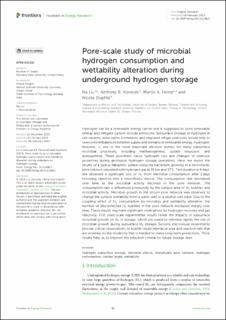| dc.contributor.author | Liu, Na | |
| dc.contributor.author | Kovscek, Anthony R. | |
| dc.contributor.author | Fernø, Martin Anders | |
| dc.contributor.author | Dopffel, Nicole | |
| dc.date.accessioned | 2024-02-15T13:11:00Z | |
| dc.date.available | 2024-02-15T13:11:00Z | |
| dc.date.created | 2023-02-14T10:48:38Z | |
| dc.date.issued | 2023 | |
| dc.identifier.issn | 2296-598X | |
| dc.identifier.uri | https://hdl.handle.net/11250/3118003 | |
| dc.description.abstract | Hydrogen can be a renewable energy carrier and is suggested to store renewable energy and mitigate carbon dioxide emissions. Subsurface storage of hydrogen in salt caverns, deep saline formations, and depleted oil/gas reservoirs would help to overcome imbalances between supply and demand of renewable energy. Hydrogen, however, is one of the most important electron donors for many subsurface microbial processes, including methanogenesis, sulfate reduction, and acetogenesis. These processes cause hydrogen loss and changes of reservoir properties during geological hydrogen storage operations. Here, we report the results of a typical halophilic sulfate-reducing bacterium growing in a microfluidic pore network saturated with hydrogen gas at 35 bar and 37°C. Test duration is 9 days. We observed a significant loss of H2 from microbial consumption after 2 days following injection into a microfluidic device. The consumption rate decreased over time as the microbial activity declined in the pore network. The consumption rate is influenced profoundly by the surface area of H2 bubbles and microbial activity. Microbial growth in the silicon pore network was observed to change the surface wettability from a water-wet to a neutral-wet state. Due to the coupling effect of H2 consumption by microbes and wettability alteration, the number of disconnected H2 bubbles in the pore network increased sharply over time. These results may have significant implications for hydrogen recovery and gas injectivity. First, pore-scale experimental results reveal the impacts of subsurface microbial growth on H2 in storage, which are useful to estimate rapidly the risk of microbial growth during subsurface H2 storage. Second, microvisual experiments provide critical observations of bubble-liquid interfacial area and reaction rate that are essential to the modeling that is needed to make long-term predictions. Third, results help us to improve the selection criteria for future storage sites. | en_US |
| dc.language.iso | eng | en_US |
| dc.publisher | Frontiers | en_US |
| dc.rights | Navngivelse 4.0 Internasjonal | * |
| dc.rights.uri | http://creativecommons.org/licenses/by/4.0/deed.no | * |
| dc.subject | Mikrobiell økologi | en_US |
| dc.subject | Microbial ecology | en_US |
| dc.subject | Hydrogenlagring | en_US |
| dc.subject | Hydrogen storage | en_US |
| dc.title | Pore-scale study of microbial hydrogen consumption and wettability alteration during underground hydrogen storage | en_US |
| dc.type | Journal article | en_US |
| dc.type | Peer reviewed | en_US |
| dc.description.version | publishedVersion | en_US |
| dc.rights.holder | Copyright 2023 The Author(s) | en_US |
| dc.source.articlenumber | 1124621 | en_US |
| cristin.ispublished | true | |
| cristin.fulltext | original | |
| cristin.qualitycode | 1 | |
| dc.identifier.doi | 10.3389/fenrg.2023.1124621 | |
| dc.identifier.cristin | 2125886 | |
| dc.source.journal | Frontiers in Energy Research | en_US |
| dc.relation.project | Norges forskningsråd: 331841 | en_US |
| dc.relation.project | Norges forskningsråd: 325457 | en_US |
| dc.subject.nsi | VDP::Teknologi: 500 | en_US |
| dc.subject.nsi | VDP::Technology: 500 | en_US |
| dc.identifier.citation | Frontiers in Energy Research. 2023, 11, 1124621. | en_US |
| dc.source.volume | 11 | en_US |

